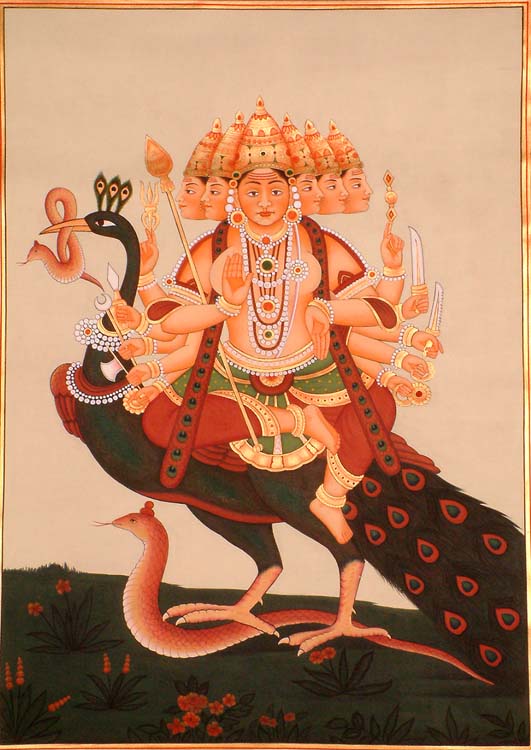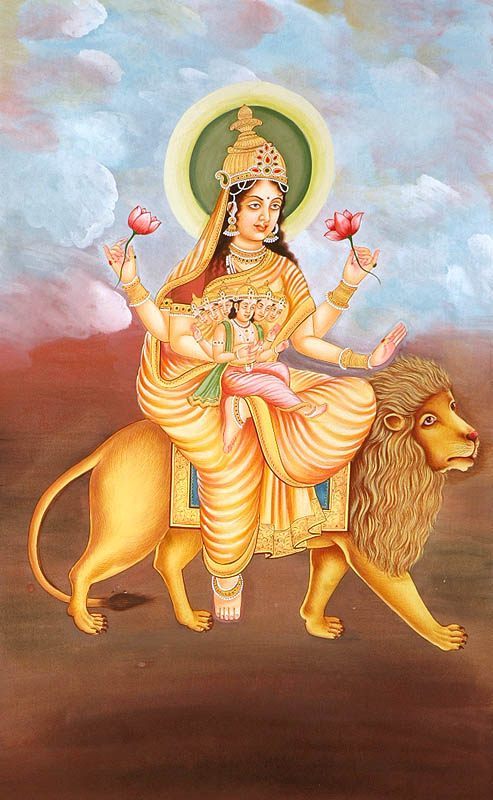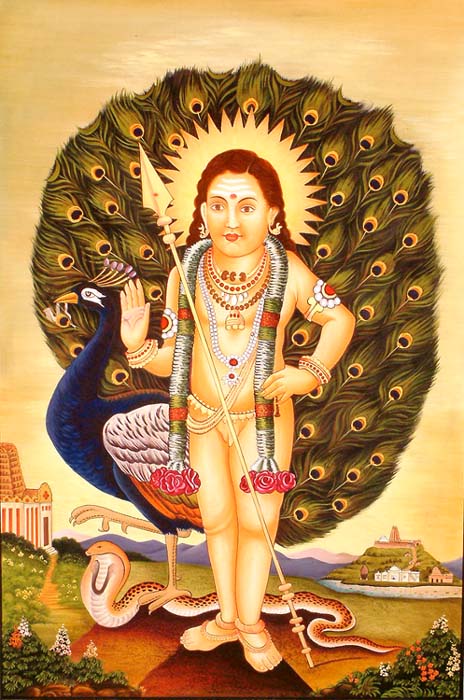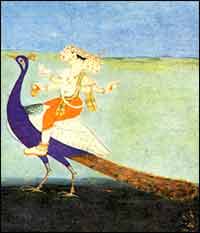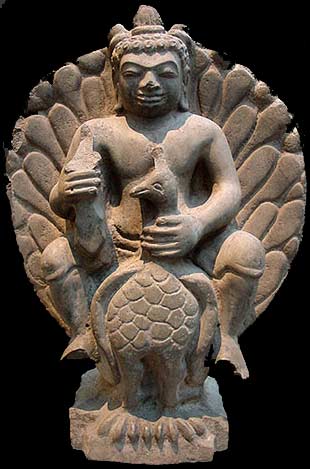
|
|||||||||||||
|
| |||||||||||||
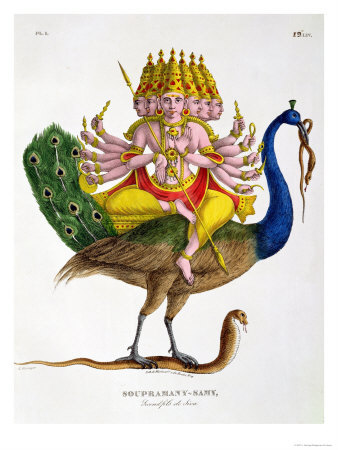
Skanda: Pan-Indian God of Love and WarThe story of Skanda, the war god of Hindu mythology, is fascinating for many reasons. To begin with, his commonest name, Skanda, has been almost forgotten today after having been in worship for over two millennia. The many interpretations, the multiple origin stories and the wildly conflicting accounts of his life and exploits that are found all over India are, in a sense, reflective of the process of Hinduism itself. Under the vast umbrella named for convenience, Hinduism, shelter a multitude of faiths and sects and philosophies. Skanda's popularity, his absorption into the official pantheon as opposed to his previous folk status, and the sudden decline in his all-India popularity to once again being a local area god, are all typical stages of this sheltering process. Skanda began his existence at a very early stage of Indian history. He seems to have been a popular war god who lived on forested hills, was fond of hunting and fighting and with an appetite for blood sacrifices. He was young, handsome and a fire-eating, spear-wielding bravo. This basic template went by many names in different parts of the country. In Maharashtra he was called Khandoba, and in vast areas of the south of India, the god was known as Malaikilavon, the Lord of the hills in ancient Tamil. His other name was Murugan. Indeed that is what he is still known as, and worshipped, where his worship has survived. The indologist Hardy had a theory that Murugan worship under different names was popular in the folk religion of the North of India too. He was supported in this by Parpola, who spent a long time attempting to decipher the script of the Indus valley. Parpola came to the conclusion that Murugan was a deity of the Indus valley culture, and that the very name Murugan is to be found in the language!
While this is not a popularly accepted view, the reason it could be put forward is the uncontested antiquity of Skanda worship. If the Indus civilization theory proves true, then Skanda is at least five thousand years old. In Maharashtra the assimilative forces of high culture could not force Khandoba out so easily and he remained an independent god, albeit recognized as an avatar of Shiva. As long as Vedic India was satisfied with its fire sacrifices and endless liturgies, it turned up its nose at popular manifestations of belief. But with the shock of Buddhism and Jainism forcing them to compete for the allegience of the faithful, the hitherto despised geographical and folk gods were absorbed into the mainstream in an act of instinctive wisdom. It is my belief that the entire Pauranic worldview is an offshoot of this process. The faith had shifted and new gods were reigning, but the guardians of the faith needed to reassure people that nothing had really changed. Hence the vast mythological outpourings that ensued. These stories were designed to fit the newly popular gods - (to the priests not to the people!) - into a nominally Vedic and Upanishadic framework. At about the sixth Century, the situation stabilized and most of the mythology was firmly in place, though perhaps not formally written down as yet. The great gods dominant in the Indian mind were Shiva, Vishnu and his avatars, Brahma, The great Goddess, Surya the sun, and Skanda. Ganapati and Laxmi were fighting a battle they would win to become more popular, but these were early days and no money was being placed on them. By the twelfth Century however, Brahma was nowhere on the scene, Surya's worship was seeing a deceptive flourish in art and architecture before it would be catastrophically extinguished and Skanda was retreating to enclaves of worship in the states of Orissa, Bengal and parts of South India, predominantly Tamil Nadu. By then however, Skanda had been accepted as the son of Shiva, and his myths had become an enduring part of the Indian imagination. It is interesting that most of the myths of Skanda deal with the vexed question of his parentage. No other figure in mythology has so many claimants for that status. Success indeed has many fathers, and in Skanda's case mothers too - eight in the most popular version the origin story! The many claimants for his parentage indicate his immense importance for rival sects, who needed the hill warrior's popularity to bolster their numbers. The Ganapati worshippers alone took an antagonistic stand when it was their time to bask in the sun, they never could forgive Skanda his head start in popularity. The Jains and Buddhists had no stories about Skanda as they did about the Vedic deities; he was too violent for them. The Mahābhārata seems to have the first version of his origin, though the Rāmāyana has a little section that covers familiar ground too. The Mahābhārata version tries to position Skanda within the ambit of Vedic deities, unlike the other versions, which are Puranic in nature. As usual the devas or gods were under threat from demonic forces. A new hero was required to deal with the problem, as the demons were immune to the old powers that be. Agni, God of Fire, goes to some great sages, to ask them to perform a sacrifice that will give him such a son. They are immersed in some sacrifice of their own and Agni has to wait. Being impatient by nature and of a fiery temperament, he pays more attention to the beautiful wives of the rishis, and is seized with desire for them. He makes obvious overtures, which they ignore. This however, is all the opportunity needed for a minor female goddess called Svāhā, who has been lusting in her heart after Agni. She assumes the forms of the wives and seduces Agni six times in succession. Each time his fiery seed is too hot for her to retain within herself, so she carries it to Mount Sveta and places it in a golden pot in a place well concealed by sara reeds. Within this obviously symbolic womb the seed is born as Subrahmanya or Skanda. In six days he is fully-grown, and he has six heads for each one of the forms assumed by Svāhā. On the sixth day this young hero is presented all the weapons of the gods and he routs the demons in an exciting battle. Thereupon he becomes the permanent warlord of the gods. He also gets Svāhā married to Agni and decrees that all offerings into the sacred fire be accompanied by the pronouncing of her name. This is a very obvious later interpolation by a morally scandalized writer. The incantation of "Svāhā" is as old as the Vedas and their rituals. This version still tries to proclaim the (now in doubt) superiority of the sacrificial ritual - even peripheral events round a sacrifice becomes cosmically significant. The ambivalent and at times openly hedonistic sexuality of the story becomes a motif of all later Skanda myths. Skanda is described variously as an extremely promiscuous young man, a protector of young women from abduction, a lifelong celibate, a happily married man, or a dandy verging on being a rake. Obviously the god served as a proxy for all the attitudes to sexuality that ever became popular in India. In the South he is married, with Sena and Valli as his two wives. That really does not say anything, as Sena means army and Valli is a personification of the Vel or lozenge shaped spear that he uses. They represent his essential nature as a warrior more than any real human women do. In Orissa and Bengal there is an interesting folk version as to why Karttikeya or Skanda is a bachelor. His mother, Parvati, wife of Shiva asked him what kind of girl he wanted to marry. His reply was, "A girl who is as beautiful as you." Appalled at the obvious oedipal connotations of this statement she 'blessed' him with perpetual celibacy. The experience seems to have turned him into a misogynist. Any woman who entered his sacred grove would instantly add to the holy vegetation by being turned into a tree or creeper! However Kārttik, as he is known in eastern India, remains the epitome of handsome valor, both courage and good looks being eulogized as being 'like Kārttik'. In the famous Kalighat Pat paintings of the late nineteenth century, Kārttik is actually shown by many painters to be wearing European dancing pumps, as some sort of continued tribute to his eternal elegance. Another peculiarity of Skanda representations in eastern India is the fact that he is always depicted as an archer, not as a spearman as in the rest of India. The hunter-god aspect remained strongest in the memory, as the forests too were abundant in the region until quite recently. However, in all parts of the country the most common feature of Skanda was his youth.
He is India's version of what would be known later in Europe as Puer Aeturnus - the eternal youth, representing not chronological age but an attitude of optimism and joyful vigor. Sculptural representations always show him as Trishikin - having three locks of hair, the mark of the eternal youth - Kumara. This notion of the Kumāra was well established by the time Kalidasa wrote his version of the origin of Skanda - Kumārasambhavam or the 'Birth of the Kumāra'. The story has changed in significant ways here and later Puranas alter it further. The demons have a leader called Tāraka, who is nominally invincible. Only the son of Shiva and Parvati can kill him, but the gods are not at all pleased at the prospect of such a new godling who would easily dominate them, having such powerful parents. At the time Tāraka was not a real threat, he was merely a prophetic warning, so they extract a foolish promise from Shiva that he will never have any children. The simple god promises but an angry Parvati retaliates with a curse that renders all the deva women sterile for all eternity. As a subconscious mechanism to explain the drying up of the Vedic stream of transmission this is hard to beat. Shiva however has only promised to forsake children, not having sex. Ages go by and the tremendous energies that build up because the god is not ejaculating now, threaten the very universe. The gods depute Agni to interrupt Shiva in his lovemaking. The angry god spills his seed, but the cunning Agni realizes it will come in very useful. He picks it up and runs to Brahma hoping to fashion a weapon out of it. The divine seed is too hot however, and the God of Fire is badly burnt. He jumps into the Ganga river hoping its sacred waters could cool it to manageable limits, but the river is in agony and casts the seed out upon a bank of sara reeds. Hence Skanda's first name sara-bhu, born in the thicket of sara reeds. Six nymphs called the Krittikās (hence the name Kārtikkeya) come to bathe and see the newly formed baby chuckling on the bank. It is so beautiful that all of them desire to suckle it, whereupon it assumes six forms so that they can all nurse it. Another version says the baby assumed six heads to simultaneously play peek a boo with his foster mothers and was nursed in turn by all of them. By now a great row breaks out as to whom the child belongs to. Agni claims him for the gods. Gangā has a good case, it was after all her liquid womb which allowed the seed to fertilize. The Krittikās argue that finders are keepers. Finally, however, Shiva gets custody of the child as it was his seed and Parvati gets a child of her own. The extraordinary nature of this tale remains a constant surprise. The decline of the old gods is clearly visible here, as well as the amazing turf battles fought by the local area gods, to associate themselves with the overarching popularity and prestige of Skanda. Shiva finally wins, because he is obviously the most mightiest god and also because his nature and habits are after all very similar to Skanda. The hill-god would be permitted a place in the official culture, but only as a son. This appropriation of Skanda by the Shiva group had many interesting consequences. For one, the Agni Purāna and the Skanda Purāna were extensively padded up with stories to reflect this new arrangement. In South India a genre of iconic representation grew up called Somāskanda, representing the infant Skanda seated on the lap of his divine parents. As late as the 17th and 18th Century, genres of miniature painting found this theme to be still attractive. These represent a sentimental turn of mind that is sometimes ghastly to see or to read. One typically twee example from the Shiva Purana should suffice.
On seeing his son, the great Lord Shiva
Placing Kumara shining with brilliant luster on her lap Parvati shone with glory as the greatest among women who carried children. Kumara, seated on Shiva's lap, played (with) and teased Vasuki, the King of the snake gods that adorned Shiva's neck. The Lord Shiva, sole ruler of the Worlds, uttered nothing, his throat choked with affection. With time Skanda worship began to trail off and it is only in Tamil Nadu that he has any significant presence. The most important temple there is on the shores of the sea and is called Tirucchentur. Other temples lie scattered about the state too and in the rest of South India. This retreat of Skanda from the other Quarters of India into the south is documented in the myth that says he was infuriated with his parents for preferring his younger brother Ganapati, when it came to who should get married first. A contest designed to solve this issue came to naught - for Skanda made the trip round the universe physically, while Ganapati merely went round his parents stating that they are the world. At a metaphysical level he was right, but Skanda went off in a rage that has still not abated. In many South Indian temples they have an annual ritual where his Himalayan dwelling parents come to visit their still sulking son! The myth also accurately potrays an increasing Indian preference for Ganapati, something that shows no sign of receding as yet. Skanda rides a peacock called Paravani- surely the perfect vehicle for a cosmic dandy. His preferred weapon is the Vel or spear hence the popular name Velāyudhan - he whose weapon is a spear. He is called Yuddharanga or the wisdom of war too. He is represented with six heads and twelve hands. He is popularly known as Subramanium too which is a common South Indian name. An interesting note on which to end this article is an unusual modern day use of the Skanda myth. The Tamil film star M.G. Ramachandran became chief minister of Tamil Nadu by skillfully using his screen persona as a do-gooder. In the rural areas of the state his canny poll managers used to distribute pamphlets that showed him as Murugan, in one of his many mythological film roles! After his death, the leadership of his party was taken over by his former costar and she continued to use the same posters, for she played Valli in those films and was asking for votes using the MGR name. Skanda's power over the popular folk imagination continues to hold fast. See also these related research articles about the cult of Skanda-Kumara in Sanskrit sources:
Index of research articles on Skanda-Murukan
|
